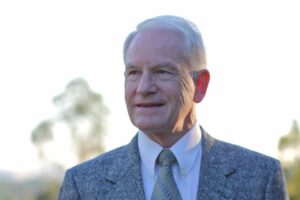About Dr. Grote
When I was four years old, I remember going to Academy Veterinary Hospital in Colorado Springs. Our Dalmation needed her vaccinations and, although I didn’t know anything about that, afterwards, whenever someone would ask what I wanted to be when I grew up, I always said, “I want to be a veterinarian.” That was my driving force through school, and when I got accepted to the College of Veterinary Medicine at Colorado State University, it was one of the defining moments of my, then, young, life. It’s now been over 50 years since I graduated with my veterinary degree. At that time, the veterinary school and hospital were on campus. I would walk by there quite often to take a look at the horses being treated (I wasn’t allowed yet to be in the hospital). One was a beautiful Quarter Horse that had a leg injury. The first time I saw him, he had a cast on his lower right front leg. The next time I visited, the lower part of his leg had been amputated and his leg was in a padded splint. I was a bit shocked and amazed. He seemed to be doing well. The final time I saw him, the clinicians had fashioned a prosthetic device, and I was again shocked and amazed. I went the next day and the stall was empty. I asked one of the students what happened and was told that beautiful horse had to be euthanized. I was saddened beyond belief. I was soon to find out that not all of these wonderful creatures, we call pets, can be saved and made well and complete again, even though that was my hope and aim. Over the many years as a veterinarian, I have helped countless dogs and cats to pass on to “their new adventure” as I look at it. I was always sad for the owners (caretakers, pet moms and dads), but happy the animal was no longer ill. Now, my entire focus is on the terminally afflicted and elderly dog and cat. I have learned so much about how to help them live longer and how to give advice to the people associated with those wonderful creatures that can’t speak for themselves. It’s been an amazing journey from dealing with all the different ages to now, just helping the older ones. I have found from my experience that there is little attention paid to how we can prolong their lives and make them comfortable, even coaching them to pass away naturally. It’s an uphill battle because the “norm” is to end “suffering”with euthanasia, in many cases before the animal is ready to pass. There is no oversight in regard to that process. No one stands back and asks the question: “Do we have to do this now or can we help them live a longer and comfortable life?” As you will see in articles that I have written and research that I have done, I don’t believe they suffer, the people around them do as they watch their beloved pet diminish in front of them. However, for the dog and the cat, they are not emotional about it. Instead, they adapt to each new moment being a new normal for them. It’s amazing to watch, but sad also because they age and change so rapidly. And so, as I started out in veterinary medicine believing I could make them all better, now I can, either by coaching a natural death or helping them to transition into a new life with wonderful medications that take all pain away and send them off across the “Rainbow Bridge.”
I also have a new website filled with information on how to help with your aging pet. Click the button underneath my photo.

